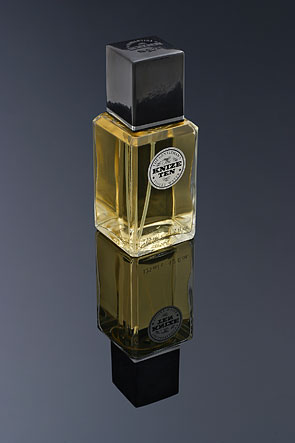The Knize Ten by Knize {Perfume Review & Musings/Part II} {Fragrances of Paris}

Knize Ten may have have had you expectant that it would hold the door for you and show off its perfectly pressed creases on its gray pearl pants while giving off "just the proper hint of Gentleman's Knize Ten cologne" as Patricia Soliman writes in Coco, The Novel, yet it suddenly morphs into a rococo, baroque form, a whirling ball gown under which some mirror-like shiny leather patent shoes peak and it suddenly is less Knize Ten and more Bal à Versailles created much later in 1962. The kinship is uncanny. It is that same treatment of the mosses and animalic odor di femina. But it could not have happened in the order we presented it to you. So what did take place? Little by little as the perfume unfolds, another familiar dancer appears that reveals yet another layer of historicity peeling back. Knize Ten becomes more clearly suffused with the golden light and round fruity peachy and plummy accents of Mitsouko by Guerlain introduced in 1919. This is a moving moment because Knize Ten now smells more like the ancient Mitsouko than the current Mitsouko itself. It has preserved this old gilded opulence and sillage of old Europe and sense of ideal Parisian elegance that have receded from Mitsouko.......
As perfumers often seek inspiration from older masterpieces, we are in this manner able to witness a moment that feels like time is standing still. Vincent Roubert somehow incorporated part of Mitsouko into Knize Ten and it was there lying dormant as in a fairytale petrified sleeping forest. Upon contact with the warmth of the skin, the golden thrills ring again and the forest is verdant and mossy once more. The complexity of our relationship to perfumes, which is but that of life itself, allows us to experience a renewed level of appreciation for the work of the perfumer. He needs not be constrained in our minds any longer by the demands of pure creativity and originality. We feel grateful in the realization that perfumers are also the guardians of a tradition and that their role of transmitters of a heritage is as profound and necessary for the good of human beings as innovation. As the olfactory memorialists of days gone by, they were able to copy intuitively perfumes they admired.
Perfumes constitute a patrimony and if someone loved and understood a perfume enough to have been able to reproduce some of its spirit and pour it into another fragrance, especially in an era where gas chromatography did not make the task one bit mechanical, then we can start to view this as the delicate attention of a museum curator, of an aesthete and collector of beautiful things paying a respectful homage that is anything but slavish. In order for the "quote" to be intimately blended into a new perfume, it has to rely on an inspirational movement and a movement of desire even if commercial considerations are present. In this case, it does not feel like a ready-made base was re-used, only, but that a golden pearl was inserted in the heart of a composition. To catch a glimpse of the artisan in the perfumer is touching and makes us understand that beauty has to be preserved, somehow, once it was discovered.
Knize Ten is at one level a masculine Mitsouko adorned with leather, yet its affinities with the latter explains also its feminine aspects, its sumptuous and sparkling texture. Much later as the dry-down develops and the golden light recedes somewhat, a more hazy impression envelops the senses of the wearer. This time it is also unmistakable; it is the suede-like soft leather drunk with flowers of Caron Tabac Blond also issued in 1919. This last reference is more discreet, yet like another ghost from the past, it also takes shape with time. As Knize Ten takes you further by the hand you go back in time a little more. Now you can feel there is the scent of the rich melancholic iris of L'Heure Bleue and behind that some of the innocence of Après L'Ondée. A whole gallery of intimate ancestors appears behind a series of secret doors and you are glad you can sense their presence one more time, like in a dream of the dead. Time stood still, then flowed back, came back again like the waves of time in this direction, that we call the present, yet it also speaks now of the upcoming autumn. Knize Ten warms you with its golden light, chills you a little with its iris fog and icy carnation, makes you think of warmly scented libraries with the fireplace lit up, of a walk in the forest one pale afternoon in October, reminds you of intimate places and moments. It also breathes its wine-y breath on you, evokes a smoking room, stables and riding crops. It carries so many things in itself, so many memories and historical depth that to wear but this one on a desert island as Hans Habe suggested, becomes for other reasons than his, the most assured way to carry a piece of old France and the city of lights as it was when lit up with gas, with you.
Top notes are bergamot, orange, lemon, petitgrain, rosemary. Heart notes are geranium, cedarwood, rose, orris, carnation, cinnamon, sandalwood. Base notes are leather, musk, moss, amber, castoreum, and vanilla. It is a very tenacious perfume that lasts overnight, with a next-day dry-down of musk and sandalwood.
(Image source is from Parfums Raffy)










I bought a bottle of Knize ten in Jermyn street london 45 years ago and I still have the original scent,it has gone a little musty but I can still flavour the original smell,I bought a new bottle 6 months ago and I still loved it ,but not as much as the original,can you still get the original one. Thanks Spencer.